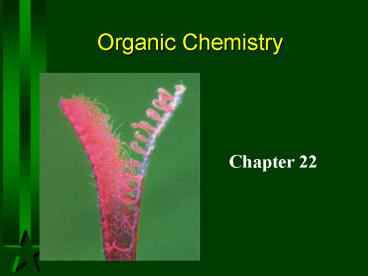Organic Chemistry - PowerPoint PPT Presentation
1 / 41
Title:
Organic Chemistry
Description:
Originally the distinction between inorganic and organic substances was based on ... C=C C C is 1-butene. The bonding in ethylene. The two stereoisomers of 2-butene. ... – PowerPoint PPT presentation
Number of Views:53
Avg rating:3.0/5.0
Title: Organic Chemistry
1
Organic Chemistry
- Chapter 22
2
Organic Chemistry
- The study of carbon-containing compounds and
their properties. - The vast majority of organic compounds contain
chains or rings of carbon atoms.
3
Organic Inorganic Compounds
- Originally the distinction between inorganic and
organic substances was based on whether or not
they were produced by living systems. - In 1828, German chemist Friedrich Wohler prepared
urea from the inorganic salt ammonium cyanate by
simple heating - heat
- NH4OCN ---gt NH2CONH2
4
Hydrocarbons
- . . . compounds composed of carbon and hydrogen.
- Saturated carbon-carbon bonds are all single -
alkanes CnH2n2
5
Hydrocarbons(continued)
- Unsaturated contains carbon-carbon multiple
bonds.
6
Hydrogen Addition
- C2H4(g) H2(g) ---gt C2H6(g)
- unsaturated saturated
7
The carbon-hydrogen bonds in methane.
8
The Lewis structure, space-filling, and
ball- and-stick models for ethane.
9
The structures of propane and butane with
109.5o bond angles.
10
Structural Isomerism
- -- isomers contain the same atoms but one or more
different bonds.
11
Normal butane (n-butane) and the branched
isomer, isobutane.
12
Isomers of Pentane
- What are the three isomers of pentane?
- 1) n-pentane -- straight-chain
- 2) isopentane -- one branch from 2nd carbon
- 3) neopentane -- two branches from central carbon
13
The straight-chain isomer, n-pentane.
14
Rules for Naming Alkanes
- 1. For alkanes beyond butane, add -ane to the
Greek root for the number of carbons. - C-C-C-C-C-C hexane
- 2. Alkyl substituents drop the -ane and add
-yl. - -C2H5 is ethyl
15
Rules for Naming Alkanes
- 3. Positions of substituent groups are specified
by numbering the longest chain sequentially. - C
- ??
- C-C-C-C-C-C
- 3-methylhexane
- 4. Location and name are followed by root alkane
name. Substituents in alphabetical order and use
di-, tri-, etc. - See Sample Exercise 22.2 on pages 1062-1064.
16
Combustion Reactions of Alkanes
- C3H8(g) 5O2(g) ----gt 3CO2(g) 4HOH(g)
- 2C4H10(g) 13 O2(g) ----gt 8CO2(g) 10HOH(g)
17
Substitution Reactions for Alkanes
- Primarily where halogen atoms replace hydrogen
atoms.
18
Dehydrogenation Reactions
- Cr2O3
- CH3CH3 ----gt CH2CH2 H2
- 500oC
- ethane
ethylene
19
Cyclic Alkanes
- Carbon atoms can form rings containing only
carbon-carbon single bonds. - C3H6, C4H8, C6H12
- Shorthand notation for the cyclic alkanes.
20
The molecular structure of cyclopropane and the
overlap of the sp3 orbitals that form the C-C
bonds.
21
The chair and boat forms of cyclohexane.
22
Alkenes and Alkynes
- Alkenes hydrocarbons that contain a
carbon-carbon double bond. CnH2n - C?CC propene
- Alkynes hydrocarbons containing a carbon-carbon
triple bond. CnH2n-2 - C?C?C?C?C 2-pentyne
23
Nomenclature for Alkenes
- 1. Root hydrocarbon name ends in -ene
- C2H4 is ethene
- 2. With more than 3 carbons, double bond is
indicated by the lowest numbered carbon atom in
the bond. - CC?C?C is 1-butene
24
The bonding in ethylene.
25
The two stereoisomers of 2-butene. a)
cis-2-butene b) trans-2-butene
26
The bonding in ethane allows rotation and
no cis-trans isomerism.
27
The bonding in acetylene.
28
Addition Reactions
- . . . in which (weaker) ? bonds are broken and
new (stronger) ? bonds are formed to atoms being
added.
propene
propane
29
Halogenation
- CH2CHCH2CH2CH3 Br2 ---gt CH2BrCHBrCH2CH2CH
3 - 1-pentene 1,2-dibromopentane
30
Aromatic Hydrocarbons
- A special class of cyclic unsaturated
hydrocarbons.
Cl2
HCl
benzene
Chlorobenzene
31
Aromatic Hydrocarbons
phenyl group
Ortho (o-) -- two adjacent substituents. meta
(m-) -- two substituents with one carbon between
them. para (p-) -- two substituents opposite
each other.
32
Refinery Processes
- Cracking large molecules broken down to smaller
ones by breaking carbon-carbon bonds. - Pyrolysis (thermal cracking) The process that
produces cracking at high temperatures. - Catalytic Cracking Cracking at lower
temperatures. - Catalytic reforming Alkanes and cycloalkanes
converted to aromatic compounds.
33
The Common Functional Groups
- Class General Formula
- Halohydrocarbons R?X
- Alcohols R?OH
- Ethers R?O?R?
- Aldehydes
34
The Common Functional Groups
- Class General Formula
- Ketones
- Carboxylic Acids
- Esters
- Amines R?NH2
- Amides R-CONH2
35
(No Transcript)
36
Alcohols
- contain the hydroxyl group (-OH).
37
Aldehydes Ketones
- contain the carbonyl group ( CO ).
- In ketones the carbonyl group is bonded to two
carbon atoms -- CH3COCH3. - In aldehydes the carbonyl group is bonded to at
least one hydrogen atom -- HCHO.
38
Carboxylic Acids Esters
- Carboxylic acids contain the carboxyl group
- O
- (-C-OH).
- O
- Esters contain the -C-O- group.
39
Amines Ethers
- Amines contain -NH2 group.
- If one hydrogen is removed and replaced with a
hydrocarbon group, it is a primary amine. - If two hydrogen are replaced, it is a secondary
amine. - If all three hydrogens are replaced, it is a
tertiary amine. - Ethers contain the -O- group.
40
Polymers
- . . . are large, usually chainlike molecules that
are built from small molecules called monomers. - Monomer Polymer
- Ethylene Polyethylene
- Vinyl chloride Polyvinyl chloride
- Tetrafluoroethylene Teflon
41
Types of Polymerization
- Addition Polymerization monomers add together
to form the polymer, with no other products.
(Teflon) - Condensation Polymerization A small molecule,
such as water, is formed for each extension of
the polymer chain. (Nylon)































